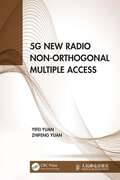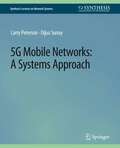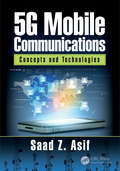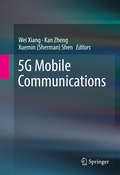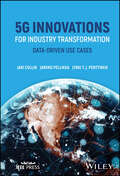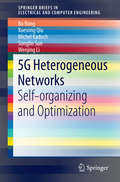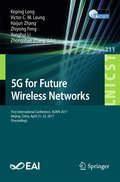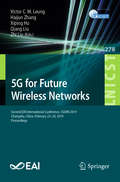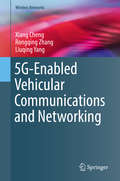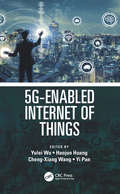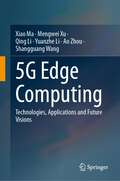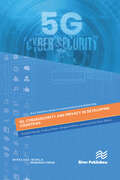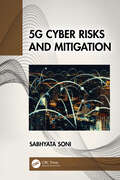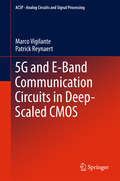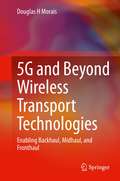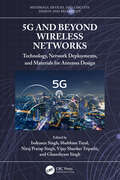- Table View
- List View
5G New Radio Non-Orthogonal Multiple Access
by Yifei Yuan Zhifeng YuanThis book provides detailed descriptions of downlink non-orthogonal multiple transmissions and uplink non-orthogonal multiple access (NOMA) from the aspects of majorly used 5G new radio scenarios and system performance. For the downlink, the discussion focuses on the candidate schemes in 3GPP standards which are not only applicable to unicast services but also to broadcast/multicast scenarios. For the uplink, the main target scenario is massive machine-type communications where grant-free transmission can reduce signaling overhead, power consumption of devices and access delays. The design principles of several uplink NOMA schemes are discussed in-depth, together with the analysis of their performances and receiver complexities. Devoted to the basic technologies of NOMA and its theoretical principles, data analysis, basic algorithms, evaluation methodology and simulation results, this book will be an essential read for researchers and students of digital communications, wireless communications engineers and those who are interested in mobile communications in general.
5G Mobile Networks: A Systems Approach (Synthesis Lectures on Network Systems)
by Larry PetersonThis book describes the 5G mobile network from a systems perspective, focusing on the fundamental design principles that are easily obscured by an overwhelming number of acronyms and standards definitions that dominate this space. The book is written for system generalists with the goal of helping bring up to speed a community that understands a broad range of systems issues (but knows little or nothing about the cellular network) so it can play a role in the network's evolution. This is a community that understands both feature velocity and best practices in building robust scalable systems, and so it has an important role to play in bringing to fruition all of 5G's potential. In addition to giving a step-by-step tour of the design rationale behind 5G, the book aggressively disaggregates the 5G mobile network. Building a disaggregated, virtualized, and software-defined 5G access network is the direction the industry is already headed (for good technical and business reasons), but breaking the 5G network down into its elemental components is also the best way to explain how 5G works. It also helps to illustrate how 5G might evolve in the future to provide even more value. An open source implementation of 5G serves as the technical underpinning for the book. The authors, in collaboration with industrial and academic partners, are working towards a cloud-based implementation that takes advantage of both Software-Defined Networking (SDN) and cloud-native (microservice-based) architectures, culminating in a managed 5G-enabled EdgeCloud-as-a-Service built on the components and mechanisms described throughout the book.
5G Mobile Core Network: Design, Deployment, Automation, and Testing Strategies
by Rajaneesh Sudhakar ShettyGet up to speed on 5G and prepare for the roll out of the next generation of mobile technology. The book begins with an introduction to 5G and the advanced features of 5G networks, where you’ll see what makes it bigger, better, and faster. You will learn 5G NSA and SA packet core design along with some design challenges, taking a practical approach towards design and deployment. Next, you will understand the testing of the 5G packet core and how to automate it. The book concludes with some advanced service provider strategies, including architectural considerations for service providers to enhance their network and provide services to non-public 5G networks.5G Mobile Core Network is intended for those who wish to understand 5G, and also for those who work extensively in a service provider environment either as operators or as vendors performing activities such as network design, deployment, testing, and automation of the network. By the end of this book you will be able to understand the benefits in terms of CAPEX and OPEX while considering one design over another. Consulting engineers will be able to evaluate the design options in terms of 5G use cases, the scale of deployment, performance, efficiency, latency, and other key considerations. What You Will Learn Understand the life cycle of a deployment right from pre-deployment phase to post-deployment phaseSee use cases of 5G and the various options to design, implement, and deploy themExamine the deployment of 5G networks to large-scale service providersDiscover the MVNO/MVNE strategies that a service provider can implement in 5GWho This Book Is For Anyone who is curious about 5G and wants to learn more about the technology.
5G Mobile Communications: Concepts and Technologies
by Saad AsifThis book will help readers comprehend technical and policy elements of telecommunication particularly in the context of 5G. It first presents an overview of the current research and standardization practices and lays down the global frequency spectrum allocation process. It further lists solutions to accommodate 5G spectrum requirements. The readers will find a considerable amount of information on 4G (LTE-Advanced), LTE-Advance Pro, 5G NR (New Radio); transport network technologies, 5G NGC (Next Generation Core), OSS (Operations Support Systems), network deployment and end-to-end 5G network architecture. Some details on multiple network elements (end products) such as 5G base station/small cells and the role of semiconductors in telecommunication are also provided. Keeping trends in mind, service delivery mechanisms along with state-of-the-art services such as MFS (mobile financial services), mHealth (mobile health) and IoT (Internet-of-Things) are covered at length. At the end, telecom sector’s burning challenges and best practices are explained which may be looked into for today’s and tomorrow’s networks. The book concludes with certain high level suggestions for the growth of telecommunication, particularly on the importance of basic research, departure from ten-year evolution cycle and having a 20–30 year plan. Explains the conceivable six phases of mobile telecommunication’s ecosystem that includes R&D, standardization, product/network/device & application development, and burning challenges and best practices Provides an overview of research and standardization on 5G Discusses solutions to address 5G spectrum requirements while describing the global frequency spectrum allocation process Presents various case studies and policies Provides details on multiple network elements and the role of semiconductors in telecommunication Presents service delivery mechanisms with special focus on IoT
5G Mobile Communications
by Wei Xiang Kan Zheng Xuemin Sherman ShenThis book provides a comprehensive overview of the emerging technologies for next-generation 5G mobile communications, with insights into the long-term future of 5G. Written by international leading experts on the subject, this contributed volume covers a wide range of technologies, research results, and networking methods. Key enabling technologies for 5G systems include, but are not limited to, millimeter-wave communications, massive MIMO technology and non-orthogonal multiple access.5G will herald an even greater rise in the prominence of mobile access based upon both human-centric and machine-centric networks. Compared with existing 4G communications systems, unprecedented numbers of smart and heterogeneous wireless devices will be accessing future 5G mobile systems. As a result, a new paradigm shift is required to deal with challenges on explosively growing requirements in mobile data traffic volume (1000x), number of connected devices (10–100x), typical end-user data rate (10–100x), and device/network lifetime (10x). Achieving these ambitious goals calls for revolutionary candidate technologies in future 5G mobile systems. Designed for researchers and professionals involved with networks and communication systems, 5G Mobile Communications is a straightforward, easy-to-read analysis of the possibilities of 5G systems.
5G LTE Narrowband Internet of Things (NB-IoT)
by Hossam FattahThis book explains the 3GPP technical specifications for the upcoming 5G Internet of Things (IoT) technology based on latest release which is Release 15. It details the LTE protocol stack of an IoT device, architecture and framework, how they are functioning and communicate with cellular infrastructure, and supported features and capability. NB-IoT is designed to connect a large number of devices in a wide range of application domains forming so-called Internet of Things (IoT). Connected devices are to communicate through cellular infrastructure. This technology is new within the 3GPP specifications and is part of upcoming new wireless technology known as 5G. Table of Contents Preface. Acknowledgments. Author. List of Abbreviations. 1. Internet of Things. 2. 4G and 5G Systems. 3. Radio Resource Control Sublayer. 4. Packet Data Convergence Protocol Sublayer. 5. Radio Link Control Sublayer. 6. Medium Access Control Sublayer. 7. Physical Sublayer. 8. Quality of Service Architecture. 9. Use Cases and Deployment. References. Index.
5G LTE Narrowband Internet of Things (NB-IoT)
by Hossam FattahThis book explains the 3GPP technical specifications for the upcoming 5G Internet of Things (IoT) technology based on latest release which is Release 15. It details the LTE protocol stack of an IoT device, architecture and framework, how they are functioning and communicate with cellular infrastructure, and supported features and capability. NB-IoT is designed to connect a large number of devices in a wide range of application domains forming so-called Internet of Things (IoT). Connected devices are to communicate through cellular infrastructure. This technology is new within the 3GPP specifications and is part of upcoming new wireless technology known as 5G. Table of Contents Preface. Acknowledgments. Author. List of Abbreviations. 1. Internet of Things. 2. 4G and 5G Systems. 3. Radio Resource Control Sublayer. 4. Packet Data Convergence Protocol Sublayer. 5. Radio Link Control Sublayer. 6. Medium Access Control Sublayer. 7. Physical Sublayer. 8. Quality of Service Architecture. 9. Use Cases and Deployment. References. Index.
5G Innovations for Industry Transformation: Data-driven Use Cases
by Jari Collin Jarkko Pellikka Jyrki T. Penttinen5G INNOVATIONS FOR INDUSTRY TRANSFORMATION Authoritative resource providing insight on real-life industrial 5G use cases in driving customer value, productivity, and sustainability ambitions With 5G innovations rapidly expanding to different areas within technology, 5G Innovations for Industry Transformation provides key information on how 5G technology can positively impact digital transformation in the industry sectors, discussing new data-driven business opportunities, including green digital transition, new standards for sustainability, and real-time data-driven services, introducing case studies that cover a variety of industries, from the oil & gas industry to the telecom industry, along with the lessons learned from these case studies, and providing insights into how 5G technology will transform businesses by sharing real-time customer solutions, fair data sharing principles, and ecosystem and change management. The book summarizes novelty aspects in a compact and practical way to benefit users and specialists in the field who want to understand some of the very key aspects of 5G. To aid in reader comprehension, the book contains tables, figures of technical principles and architectural block diagrams, and photographs further explaining key topics. Sample topics covered in 5G Innovations for Industry Transformation include: 5G SA technology with new capabilities, 5G private networks, and how smart, connected products are transforming competition Implications of 5G applied to your particular business and/or industry, and how to scale up and industrialize based on these implications How to lead the charge in relation to optimizing business practices based on the advent of 5G, and details on navigating the platform economy How 5G affects data privacy and security, and other integrated capabilities of 5G, such as processes, data, technology, and competencies Based on real-world experiences and high-quality research and presenting practical examples that serve as a useful guiding hand, 5G Innovations for Industry Transformation is an essential resource for change leaders, enterprise architects, and software developers of any industrial enterprise seeking to drive digitalization forward in their value chain and organization.
5G Innovations for Industry Transformation: Data-driven Use Cases
by Jari Collin Jarkko Pellikka Jyrki T. Penttinen5G INNOVATIONS FOR INDUSTRY TRANSFORMATION Authoritative resource providing insight on real-life industrial 5G use cases in driving customer value, productivity, and sustainability ambitions With 5G innovations rapidly expanding to different areas within technology, 5G Innovations for Industry Transformation provides key information on how 5G technology can positively impact digital transformation in the industry sectors, discussing new data-driven business opportunities, including green digital transition, new standards for sustainability, and real-time data-driven services, introducing case studies that cover a variety of industries, from the oil & gas industry to the telecom industry, along with the lessons learned from these case studies, and providing insights into how 5G technology will transform businesses by sharing real-time customer solutions, fair data sharing principles, and ecosystem and change management. The book summarizes novelty aspects in a compact and practical way to benefit users and specialists in the field who want to understand some of the very key aspects of 5G. To aid in reader comprehension, the book contains tables, figures of technical principles and architectural block diagrams, and photographs further explaining key topics. Sample topics covered in 5G Innovations for Industry Transformation include: 5G SA technology with new capabilities, 5G private networks, and how smart, connected products are transforming competition Implications of 5G applied to your particular business and/or industry, and how to scale up and industrialize based on these implications How to lead the charge in relation to optimizing business practices based on the advent of 5G, and details on navigating the platform economy How 5G affects data privacy and security, and other integrated capabilities of 5G, such as processes, data, technology, and competencies Based on real-world experiences and high-quality research and presenting practical examples that serve as a useful guiding hand, 5G Innovations for Industry Transformation is an essential resource for change leaders, enterprise architects, and software developers of any industrial enterprise seeking to drive digitalization forward in their value chain and organization.
5G Heterogeneous Networks: Self-organizing and Optimization (SpringerBriefs in Electrical and Computer Engineering)
by Bo Rong Xuesong Qiu Michel Kadoch Songlin Sun Wenjing LiThis SpringerBrief provides state-of-the-art technical reviews on self-organizing and optimization in 5G systems. It covers the latest research results from physical-layer channel modeling to software defined network (SDN) architecture. This book focuses on the cutting-edge wireless technologies such as heterogeneous networks (HetNets), self-organizing network (SON), smart low power node (LPN), 3D-MIMO, and more. It will help researchers from both the academic and industrial worlds to better understand the technical momentum of 5G key technologies.
5G for Future Wireless Networks: First International Conference, 5GWN 2017, Beijing, China, April 21-23, 2017, Proceedings (Lecture Notes of the Institute for Computer Sciences, Social Informatics and Telecommunications Engineering #211)
by Keping Long Victor C.M. Leung Haijun Zhang Zhiyong Feng Yonghui Li Zhongshan ZhangThis book constitutes the proceedings of the First International Conference on 5G for Future Wireless Networks, 5GWN 2017, held in Beijing, China, in April 2017. The 64 full papers were selected from 135 submissions and present the state of the art and practical applications of 5G technologies. The exponentially growing data traffic caused by the development of mobile Internet and smart phones requires powerful networks. The fifth generation (5G) techniques are promising to meet the requirements of this explosive data traffic in future mobile communications.
5G for Future Wireless Networks: Second EAI International Conference, 5GWN 2019, Changsha, China, February 23-24, 2019, Proceedings (Lecture Notes of the Institute for Computer Sciences, Social Informatics and Telecommunications Engineering #278)
by Haijun Zhang Xiping Hu Qiang Liu Zhi Liu Victor C. LeungThis book constitutes the proceedings of the Second International Conference on 5G for Future Wireless Networks, 5GWN 2019, held in Changsa, China, in February 2019. The 13 full papers were selected from 34 submissions and present the state of the art and practical applications of 5G technologies. The papers are arranged thematically on optimization theory and applications, intelligent computing technology for 5G applications, resource allocation and management, and security and privacy in emerging 5G applications.
5G-Enabled Vehicular Communications and Networking (Wireless Networks)
by Xiang Cheng Rongqing Zhang Liuqing YangThis book investigates and reviews recent advanced techniques and important applications in vehicular communications and networking (VCN) from a novel perspective of the combination and integration of VCN and connected vehicles, which provides a significant scientific and technical support for future 5G-based VCN.5G-Enabled Vehicular Communications and Networking introduces vehicular channel characteristics, reviews current channel modeling approaches, and then provides a new generic geometry-based stochastic modeling approach for vehicle-to-everything (V2X) communications. The investigation of vehicular channel measurements and modeling provides fundamental supports for the VCN system design. Then, this book investigates VCN-vehicle combination from PHY and MAC layers, respectively. As for the PHY layer, many advanced techniques that can be effectively applied in VCN to counter the PHY challenges are introduced, including novel ICI cancellation methods, index modulated OFDM, differential spatial modulation, and energy harvesting relaying. As for the MAC layer, distributed and centralized MAC designs are analyzed and compared in terms of feasibility and availability. Specifically, distributed congestion control, D2D-enabled vehicular communications, and centralized data dissemination scheduling are elaborated, which can significantly improve the network performance in vehicular networks. Finally, considering VCN-vehicle integration, this book introduces several hot-topic applications in vehicular networks, including electric vehicles, distributed data storage, unmanned aerial vehicles, and security and privacy, which indicates the significance and development value of VCN-vehicle integration in future vehicular networks and our daily life. The primary audience for this book includes professionals and researchers working in the field of vehicular communications, intelligent transportation systems (ITS), and Internet of vehicles (IoV). Advanced level students studying electrical engineering will also find this book useful as a secondary textbook for related courses.
5G-Enabled Internet of Things
by Yi Pan Yulei Wu Cheng-Xiang Wang Haojun HuangHow the enabling technologies in 5G as an integral or as a part can seamlessly fuel the IoT revolution is still very challenging. This book presents the state-of-the-art solutions to the theoretical and practical challenges stemming from the integration of 5G enabling technologies into IoTs in support of a smart 5G-enabled IoT paradigm, in terms of network design, operation, management, optimization, privacy and security, and applications. In particular, the technical focus covers a comprehensive understanding of 5G-enabled IoT architectures, converged access networks, privacy and security, and emerging applications of 5G-eabled IoT.
5G-Enabled Internet of Things
by Yi Pan Yulei Wu Cheng-Xiang Wang Haojun HuangHow the enabling technologies in 5G as an integral or as a part can seamlessly fuel the IoT revolution is still very challenging. This book presents the state-of-the-art solutions to the theoretical and practical challenges stemming from the integration of 5G enabling technologies into IoTs in support of a smart 5G-enabled IoT paradigm, in terms of network design, operation, management, optimization, privacy and security, and applications. In particular, the technical focus covers a comprehensive understanding of 5G-enabled IoT architectures, converged access networks, privacy and security, and emerging applications of 5G-eabled IoT.
5G Edge Computing: Technologies, Applications and Future Visions
by Qing Li Shangguang Wang Ao Zhou Xiao Ma Mengwei Xu Yuanzhe LiEdge computing has been identified as one of the key technologies for 5G networks and beyond due to two prominent advantages: low network latency and reduced core network load. By empowering cloud capabilities and IT service environments at the network edge, edge computing can well support applications of 5G and beyond, such as augmented/virtual reality (AR/VR), vehicular network (ultra-reliable low-latency communication services),Internet of Things (massive machine type communication services), and mobile high-definition video (enhanced mobile broadband services). Therefore, edge computing has attracted the attention of both industry and academia since its emergence. This book highlights the progress of 5G edge computing in both industry and academia according to our long-term efforts, including the current practice of public edge providers, the research process of edge computing from academia, the integration of edge computing with 5G, and the future visions of edge computing in the 6G era. From this book, the readers can benefit from: (1) the first comprehensive measurement study on a leading public edge platform, NEP (next-generation edge platform); 2) a clear and in-depth introduction of the key technologies of 5G edge computing; (3) the latest progress of 5G-integrated edge computing; and (4) pioneering exploration of 6G edge computing based on Tiansuan constellation – an open satellite-terrestrial integrated platform. Both the researchers from academia or practitioners from industry can benefit significantly from this book.
5G, Cybersecurity and Privacy in Developing Countries (River Publishers Series in Communications and Networking)
by Knud Erik Skouby Prashant Dhotre Idongesit Williams Kamal Hiran5G, the emerging technology in mobile communication, is expected to deliver an important and decisive impact on several of the UN’s Sustainable Development Goals where universal accessibility to ICTs remains a serious concern. However, cyber security has emerged as a serious challenge, not least because of the increased accessibility and broader usage with associated vulnerability. Developing countries have additional challenges associated with both the expected faster build-up of accessibility and lack of qualified competencies within cyber security. Discussion of these challenges is the overall theme and motivation for this book. Technical topics discussed in the book include: 5G in rural networks Critical infrastructures Open RAN Protection of privacy Cybersecurity and machine learning Cybersecurity and disaster monitoring
5G, Cybersecurity and Privacy in Developing Countries (River Publishers Series in Communications and Networking)
by Knud Erik Skouby Prashant Dhotre Idongesit Williams Kamal Kant Hiran5G, the emerging technology in mobile communication, is expected to deliver an important and decisive impact on several of the UN’s Sustainable Development Goals where universal accessibility to ICTs remains a serious concern. However, cyber security has emerged as a serious challenge, not least because of the increased accessibility and broader usage with associated vulnerability. Developing countries have additional challenges associated with both the expected faster build-up of accessibility and lack of qualified competencies within cyber security. Discussion of these challenges is the overall theme and motivation for this book. Technical topics discussed in the book include: 5G in rural networks Critical infrastructures Open RAN Protection of privacy Cybersecurity and machine learning Cybersecurity and disaster monitoring
5G Cyber Risks and Mitigation
by Sabhyata Soni5 G technology is the next step in the evolution of wireless communication. It offers faster speeds and more bandwidth than 4G. One of the biggest differences between 4G and 5G is that 5G will be used for a wider range of applications. This makes it ideal for applications such as autonomous vehicles, smart cities, and the internet of things. This means that there will be more devices connected to 5G networks, making them more vulnerable to cyber attacks. However, 5 G also introduces new cyber risks that need to be addressed. In addition, 5 G networks are expected to be much more complex, making them harder to secure. 5G networks will use new technologies that could make them more vulnerable to attack. These technologies include massive MIMO (multiple input, multiple output), which uses more antennas than traditional cellular networks, and millimeter wave (mmWave), which uses higher frequencies than traditional cellular networks. These new technologies could make it easier for attackers to intercept data or disrupt service. To address these concerns, security measures must be implemented throughout the network. Security mechanisms must be included in the design of 5G networks and must be updated as new threats are identified. Moreover, to address these risks, 5 G security standards need to be developed and implemented. These standards should include measures to protect against Denial of Service (DoS) attacks, malware infections, and other threats. Fortunately, artificial intelligence can play a key role in mitigating these risks. With so many interconnected devices, it can be difficult to identify and isolate malicious traffic. AI can help by identifying patterns in data that would otherwise be undetectable to humans. 6G technology is still in the early developmental stages, but security experts are already voicing concerns about the potential challenges that could arise with this next generation of mobile connectivity. Experts are already working on a roadmap for 6G deployment, and they are confident that these and other challenges can be overcome.
5G Cyber Risks and Mitigation
by Sabhyata Soni5 G technology is the next step in the evolution of wireless communication. It offers faster speeds and more bandwidth than 4G. One of the biggest differences between 4G and 5G is that 5G will be used for a wider range of applications. This makes it ideal for applications such as autonomous vehicles, smart cities, and the internet of things. This means that there will be more devices connected to 5G networks, making them more vulnerable to cyber attacks. However, 5 G also introduces new cyber risks that need to be addressed. In addition, 5 G networks are expected to be much more complex, making them harder to secure. 5G networks will use new technologies that could make them more vulnerable to attack. These technologies include massive MIMO (multiple input, multiple output), which uses more antennas than traditional cellular networks, and millimeter wave (mmWave), which uses higher frequencies than traditional cellular networks. These new technologies could make it easier for attackers to intercept data or disrupt service. To address these concerns, security measures must be implemented throughout the network. Security mechanisms must be included in the design of 5G networks and must be updated as new threats are identified. Moreover, to address these risks, 5 G security standards need to be developed and implemented. These standards should include measures to protect against Denial of Service (DoS) attacks, malware infections, and other threats. Fortunately, artificial intelligence can play a key role in mitigating these risks. With so many interconnected devices, it can be difficult to identify and isolate malicious traffic. AI can help by identifying patterns in data that would otherwise be undetectable to humans. 6G technology is still in the early developmental stages, but security experts are already voicing concerns about the potential challenges that could arise with this next generation of mobile connectivity. Experts are already working on a roadmap for 6G deployment, and they are confident that these and other challenges can be overcome.
5G and Next-Gen Consumer Banking Services
by Krunoslav Ris, PhDThe future has already begin. The banking industry needs to adjust, or it will disappear in the next decade. With the help of 5G, next-generation intelligent ATM-like devices will have highly integrated functions and use technologies such as artificial intelligences-assisted self-service contactless interfaces with facial recognition and digital signatures. This book focuses on new experiences that clients can expect when connected to a 5G network with a 5G device. By 2022 we hope that 5G will: Drive accelerated mBanking growth Power augmented reality /virtual reality Make Video shopping experiences more widespread and compelling Enable banks to deploy highly personalized customer service experiences Support time-sensitive banking applications, like online stock trading where milliseconds can determine a gain or loss Improve security and fraud prevention bycomputing and exchanging more data traveling between parties in real-time Enhance mPOS transactions and utilization. 5G holds the potential to accelerate mobile point of sale (MPOS) transaction processing time and improve connectivity In order to explore these topics, this book covers: • Decentralization of the banks • Banking without banks • 5G will change the modern banking industry • Blockchain adoption by the banking industry
5G and Next-Gen Consumer Banking Services
by Krunoslav Ris, PhDThe future has already begin. The banking industry needs to adjust, or it will disappear in the next decade. With the help of 5G, next-generation intelligent ATM-like devices will have highly integrated functions and use technologies such as artificial intelligences-assisted self-service contactless interfaces with facial recognition and digital signatures. This book focuses on new experiences that clients can expect when connected to a 5G network with a 5G device. By 2022 we hope that 5G will: Drive accelerated mBanking growth Power augmented reality /virtual reality Make Video shopping experiences more widespread and compelling Enable banks to deploy highly personalized customer service experiences Support time-sensitive banking applications, like online stock trading where milliseconds can determine a gain or loss Improve security and fraud prevention bycomputing and exchanging more data traveling between parties in real-time Enhance mPOS transactions and utilization. 5G holds the potential to accelerate mobile point of sale (MPOS) transaction processing time and improve connectivity In order to explore these topics, this book covers: • Decentralization of the banks • Banking without banks • 5G will change the modern banking industry • Blockchain adoption by the banking industry
5G and E-Band Communication Circuits in Deep-Scaled CMOS (Analog Circuits and Signal Processing)
by Marco Vigilante Patrick ReynaertThis book discusses design techniques, layout details and measurements of several key analog building blocks that currently limit the performance of 5G and E-Band transceivers implemented in deep-scaled CMOS. The authors present recent developments in low-noise quadrature VCOs and tunable inductor-less frequency dividers. Moreover, the design of low-loss broadband transformer-based filters that realize inter-stage matching, power division/combining and impedance transformation is discussed in great detail. The design and measurements of a low-noise amplifier, a downconverter and a highly-linear power amplifier that leverage the proposed techniques are shown. All the prototypes were realized in advanced nanometer scaled CMOS technologies without RF thick to metal option.
5G and Beyond Wireless Transport Technologies: Enabling Backhaul, Midhaul, and Fronthaul
by Douglas H MoraisThis text covers the key technologies employed in wireless links that enable increased data rates and thus are likely to be employed in support of 5G wireless transport networks, i.e., backhaul, midhaul, and fronthaul networks. The author presents technologies at an introductory level but nonetheless at a level that imparts to the reader a sound understanding of the fundamentals. The book is intended for those practicing engineers and graduate and upper undergraduate students who have an interest in acquiring, where missing, the necessary technology background in order to comprehend the functioning and capability of 5G based wireless transport links. The author focuses on those technologies that are key to achieving the high data rates and high reliability required of this transport. The material is presented in a clear, concise, and mathematically light fashion.Covers key wireless transport (backhaul, midhaul, and fronthaul) technologies for 5G and beyond, presented in a clear tractable fashion;Outlines the basic wireless transport transmitter/receiver terminal architecture, provides specifications of some such terminals, and indicates the link performance afforded by such terminals;Provides sufficient mathematics to make it technically coherent, but not so much as to make it challenging for a reader with no or limited familiarity with these technologies.
5G and Beyond Wireless Networks: Technology, Network Deployments, and Materials for Antenna Design (Materials, Devices, and Circuits)
by Indrasen Singh Shubham Tayal Niraj Pratap Singh Vijay Shanker Tripathi Ghanshyam Singh5G and Beyond Wireless Networks: Technology, Network Deployments, and Materials for Antenna Design offers a comprehensive overview of 5G and beyond 5G wireless networks along with emerging technologies that support the design and development of wireless networks. It also includes discussions on various materials used for practical antenna design which are suitable for 5G, beyond 5G applications, and cell-free massive MIMO systems.The book discusses the latest techniques used in 5G and beyond 5G (B5G) communication, such as non-orthogonal multiple access (NOMA), device-to-device (D2D) communication, 6G ultra-dense O-RAN, rate-splitting multiple access (RSMA), simultaneous wireless information and power transfer (SWIPT), massive multiple input multiple output (mMIMO), and cell-free massive MIMO systems, which are explained in detail for 5G and beyond cellular networks. The description of NOMA and their benefit for 5G and beyond networks is also addressed along with D2D communication for next generation cellular networks. RSMA technique is also explained for 6G communication. Detailed descriptions for the design and development of 5G and beyond networks over various techniques are included. The materials specification to design antenna for 5G application are also given.The role of metalens in designing effective antennas and material specifications for 5G applications is explained in this book. Apart from the above emerging topics, this book also gives ideas about intelligent communication, Internet of Multimedia Things (IOMT), millimeter-wave MIMO-UFMC, and fog computing cloud networks. The last chapter gives details about the legal frameworks for 5G technology for responsible and sustainable deployment. Overall, this book may benefit network design engineers and researchers working in the area of next generation cellular networks.The contents of this book will be helpful for young researchers and master students, and network design engineers who are working in the area of next generation cellular networks.
